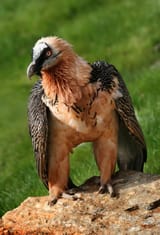Search Results
6/17/2025, 1:07:17 AM
The bearded vulture, also known as the lammergeier or ossifrage, is the only known vertebrate whose diet consists almost entirely of bone. This unique scavenger consumes between 70 to 90 percent bone, including bone marrow, and is capable of swallowing or biting through brittle bones as large as a lamb's femur. Unlike other vultures that primarily consume meat, the bearded vulture typically disdains the meat and focuses on skeletal remains, making it the only bird species that specializes in feeding on bones.
Its digestive system is uniquely adapted to this diet, featuring extremely strong stomach acid with a pH of about 1, which dissolves bone within 24 hours.
If bones are too large to swallow, the vulture will drop them from great heights onto rocky surfaces to break them into smaller, manageable pieces—a behavior that has earned certain locations the ominous name "ossuaries".
The bearded vulture is found in parts of Africa, Asia, and Europe, typically inhabiting mountainous regions, plains, and lowlands. Despite its wide historical range, the species has experienced significant declines due to habitat loss, poisoning, and persecution fueled by myths that it preys on livestock and even children.
As of recent assessments, the species is categorized as Near Threatened globally, with European populations classified as Vulnerable. Conservation efforts are ongoing to protect and restore this remarkable bird’s populations.
One badass bird
Its digestive system is uniquely adapted to this diet, featuring extremely strong stomach acid with a pH of about 1, which dissolves bone within 24 hours.
If bones are too large to swallow, the vulture will drop them from great heights onto rocky surfaces to break them into smaller, manageable pieces—a behavior that has earned certain locations the ominous name "ossuaries".
The bearded vulture is found in parts of Africa, Asia, and Europe, typically inhabiting mountainous regions, plains, and lowlands. Despite its wide historical range, the species has experienced significant declines due to habitat loss, poisoning, and persecution fueled by myths that it preys on livestock and even children.
As of recent assessments, the species is categorized as Near Threatened globally, with European populations classified as Vulnerable. Conservation efforts are ongoing to protect and restore this remarkable bird’s populations.
One badass bird
Page 1
